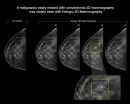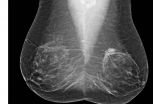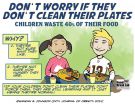(Press-News.org) CHICAGO - A major new study being presented at the annual meeting of the Radiological Society of North America (RSNA) has found that digital breast tomosynthesis, also known as 3-D mammography, has the potential to significantly increase the cancer detection rate in mammography screening of women with dense breasts.
Breasts are considered dense if they have a lot of fibrous or glandular tissue but not much fatty tissue. Research has shown that dense breasts are more likely to develop cancer, a problem compounded by the fact that cancer in dense breasts can be difficult to detect on mammograms.
Other imaging modalities like ultrasound and MRI are often used to help find cancers that can't be seen on mammograms, but both modalities have higher rates of false-positive findings, which are suspicious findings that turn out not to be cancer. This higher false-positive rate often results in more tests and unnecessary biopsies, making MRI and ultrasound expensive to implement in high-volume screening programs, according to study lead author Per Skaane, M.D., Ph.D., from the Department of Radiology at Oslo University Hospital in Oslo, Norway.
Dr. Skaane and colleagues have been studying tomosynthesis as a promising breast cancer screening option that addresses some of the limitations of mammography by providing 3-D views of the breast.
"Tomosynthesis could be regarded as an improvement of mammography and would be much easier than MRI or ultrasound to implement in organized screening programs," Dr. Skaane said. "So the intention of our study was to see if tomosynthesis really would significantly increase the cancer detection rate in a population-based mammography screening program."
The researchers compared cancer detection using full-field digital mammography (FFDM) versus FFDM plus digital breast tomosynthesis in 25,547 women between the ages of 50 and 69. Breast density was classified based on the American College of Radiology's Breast Imaging-Reporting and Data System (BI-RADS). The BI-RADS breast density scale runs from 1 to 4, with 1 being the least dense and 4 being the most dense.
There were 257 malignancies detected on FFDM and a combination of FFDM and tomosynthesis in the study group, including 105 in the density 2 group and 110 in density 3. Of the 257 cancers, 211, or 82 percent were detected with FFDM plus tomosynthesis, a significant improvement over the 163, or 63 percent, detected with FFDM alone.
FFDM plus tomosynthesis pinpointed 80 percent of the 132 cancer cases in women with dense breasts, compared to only 59 percent for FFDM alone.
"Our findings are extremely promising, showing an overall relative increase in the cancer detection rate of about 30 percent," Dr. Skaane said. "Stratifying the results on invasive cancers only, the relative increase in cancer detection was about 40 percent."
Tomosynthesis not only improved the cancer detection rate in women with dense breasts, it also helped increase detection for women in the "fatty breast" BI-RADS categories. The addition of tomosynthesis to FFDM improved the cancer detection rate from 68 percent to 84 percent in women with BI-RADS density 1 or 2 breasts.
"Our results show that implementation of tomosynthesis might indicate a new era in breast cancer screening," Dr. Skaane said.
INFORMATION:
Co-authors on the study are Bjorn Helge Osteras, M.Sc., Ellen B. Eben, M.D., and Randi Gullien, R.T.
Copies of RSNA 2014 news releases and electronic images will be available online at RSNA.org/press14 beginning Monday, Dec. 1.
RSNA is an association of more than 54,000 radiologists, radiation oncologists, medical physicists and related scientists, promoting excellence in patient care and health care delivery through education, research and technologic innovation. The Society is based in Oak Brook, Ill.
For patient-friendly information on breast imaging, visit RadiologyInfo.org.
CHICAGO - A study of breast cancers detected with screening mammography found that strong family history and dense breast tissue were commonly absent in women between the ages of 40 and 49 diagnosed with breast cancer. Results of the study were presented today at the annual meeting of the Radiological Society of North America (RSNA).
"Screening recommendations for this age group continue to be debated," said Bonnie N. Joe, M.D., Ph.D., associate professor in residence and chief of women's imaging at University of California, San Francisco (UCSF). "Recent publications ...
CHICAGO - Patients value direct, independent access to their medical exams, according to a new study presented at the annual meeting of the Radiological Society of North America (RSNA).
Fragmentation of health information among physicians, healthcare institutions or practices, and inefficient exchange of test results can decrease quality of care and contribute to high medical costs. Improving communications and giving patients more control over their care are critical goals of health IT initiatives.
"Easy and timely electronic access to an online unified source of ...
Disparities in mental-health treatment are known to be associated with patients' racial and ethnic backgrounds. Now, a large study by researchers with UC Davis has found one possible reason for those disparities: Some racial and ethnic minorities are less likely to be assessed and referred for treatment by their medical providers.
The study of more than 9,000 diverse individuals, including Latinos, African-Americans, Asian-Americans and non-Hispanic whites, found that patients of different racial and ethnic backgrounds reported experiencing differing treatment approaches ...
ANN ARBOR, Mich. -- Patients with head and neck cancer who used antacid medicines to control acid reflux had better overall survival, according to a new study from the University of Michigan Comprehensive Cancer Center.
Reflux can be a common side effect of chemotherapy or radiation treatment for head and neck cancer. Doctors at the University of Michigan frequently prescribe two types of antacids - proton pump inhibitors or histamine 2 blockers - to help treat this side effect.
The researchers looked at 596 patients who were treated for head and neck cancer. More than ...
Sons whose fathers have criminal records tend to have lower cognitive abilities than sons whose fathers have no criminal history, data from over 1 million Swedish men show. The research, conducted by scientists in Sweden and Finland, indicates that the link is not directly caused by fathers' behavior but is instead explained by genetic factors that are shared by father and son.
The study is published in Psychological Science, a journal of the Association for Psychological Science.
"The findings are important because cognitive ability is among the most important psychological ...
EVANSTON, Ill. --- Birth weight makes a difference to a child's future academic performance, according to new Northwestern University research that found heavier newborns do better in elementary and middle school than infants with lower birth weights.
Led by a multidisciplinary team of Northwestern researchers, the study raises an intriguing question: Does a fetus benefit from a longer stay in the mother's womb?
"A child who is born healthy doesn't necessarily have a fully formed brain," said David Figlio, one of the study's authors and director of Northwestern's Institute ...
Gorlin syndrome causes an increased risk of developing cancers of the skin and, rarely, in the brain. Around 1 in 30,000 people has the condition.
Most people with Gorlin syndrome have a change in a gene called PTCH1, but the new research has revealed that changes in a gene called SUFU also cause Gorlin syndrome and it is children with a change in SUFU that are 20 times more likely to develop a brain tumour.
Dr Miriam Smith, a lecturer in cancer genomics from the University's Institute of Human Development led the research, which was also carried out with The Christie ...
Whereas most adults are members of the Clean Plate Club, they eat an average of about 90% of the food they serve themselves, this is not true for children.
New Cornell research aggregated six different studies of 326 elementary school-aged children. It showed that, if their parents are not around, the average child only eats about 60% of what they serve themselves. More than a third goes right in the trash.
Unlike adults, kids are still learning about what foods they like and how much it will take to fill them up. "It's natural, for them to make some ...
Vitamin D supplements can reduce COPD lung disease flare-ups by over 40% in patients with a vitamin D deficiency - according to new research from Queen Mary University of London. COPD (chronic obstructive pulmonary disease) includes conditions such as chronic bronchitis and emphysema, and is thought to affect more than 3 million people in the UK.
The NIHR-funded randomised trial, published in the journal Lancet Respiratory Medicine, included 240 patients with COPD in and around London. Half of the patients (122) received vitamin D supplements (6 x 2-monthly oral doses ...
Muslim communities may not be as victimised by violent crime, or as dissatisfied with the police as is widely suggested and believed, according to new research by a Cambridge academic.
An examination of statistics taken from the Crime Survey of England and Wales between 2006 and 2010 reveals a surprising counter-narrative to commonly-held perceptions of British Muslim communities and their relationships to crime victimization and the criminal justice system.
Analysis of crime data generated by nearly 5,000 Muslims reveals few differences between Muslims and non-Muslims ...


